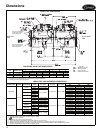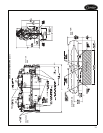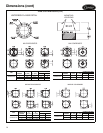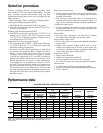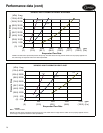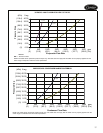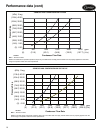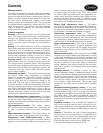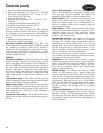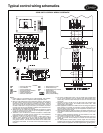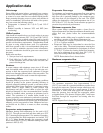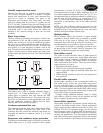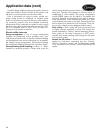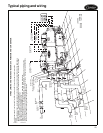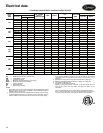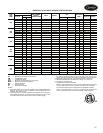
20
• Evaporator entering fluid temperature (T2)
• Suction gas temperature (T4 - Circuit A, T7 - Circuit B)
• Economizer gas temperature (T5 - Circuit A, T11 -
Circuit B) (sizes 350, 400 only)
• Space temperature (T8)
• Discharge gas temperature (T9 - Circuit A, T10 -
Circuit B)
• Condenser entering fluid temperature (T12)
• Condenser leaving fluid temperature (T13)
• Compressor motor temperature
There are 3 (size 325) or 4 (sizes 350, 400) refrigerant
pressure transducers used in each circuit for sensing suc-
tion, discharge, oil, and economizer (sizes 350, 400) pres-
sure. The microprocessor uses these inputs to control
capacity.
• Saturated condensing temperature
• Evaporator saturation temperature
Electronic expansion valve (EXV) — The EXV con-
trols refrigerant flow to the evaporator for different operat-
ing conditions by varying an orifice size to increase or
decrease the flow area through the valve based on micro-
processor input. The orifice is positioned by a stepper
motor through approximately 3,600 discrete steps and is
monitored every 3 seconds.
Safeties
Abnormal conditions — All control safeties in the chiller
operate through compressor protection board, control
relays or the chiller microprocessor. Loss of feedback sig-
nal to the MBB will cause the compressor(s) to shut down.
For other safeties, the microprocessor makes appropriate
decision to shut down a compressor due to a safety trip or
bad sensor reading and displays the appropriate failure
code on the display. Chiller holds in safety mode until
reset; it then reverts to normal control when the unit is
reset.
Low-pressure safety — This safety will shut down the
chiller and display the appropriate alarm code if the system
pressure drops below configured minimums.
High-pressure safety — This safety will shut down the
chiller and display the appropriate alarm code if the com-
pressor discharge pressure increases to 185 psig for stan-
dard condenser units or 250 psig for high condensing or
heat machine units.
Compressor anti-cycling — This feature monitors com-
pressor starts to limit compressor cycling during periods of
low load.
Loss of flow protection — This feature will shut off the
chiller if the detected flow is below the configured mini-
mum flow rate. Thermal dispersion flow switches are
installed in 30XW chillers to confirm evaporator flow.
Sensor failures — The microprocessor monitors tem-
perature and pressure sensors to ensure readings are
within the expected range. Loss of communication to a
sensor or readings outside of the expected range will
prompt corrective action.
Other safeties — Other safety features include electric
overload, thermal overload protection, oil pressure, loss of
refrigerant charge, loss of phase protection, reverse
rotation protection (prevents compressor start), current
imbalance, and ground current.
Demand limit function — This function can be used to
limit the total power draw of the chiller to a user-defined
set point. The optional energy management module is
required and can provide either 2-step or 4 to 20 mA
demand limit. This optional electronic board interfaces
with the microprocessor to control the number of com-
pressors operating and their operating capacity to limit
power consumption to the user specified value.
The microprocessor can control the number of compres-
sors operating and their operating capacity to limit power
consumption to the user specified value.
Diagnostics — The microprocessor includes a service
test feature that displays the condition of each sensor and
switch in the chiller and allows the observer to check for
proper operation of the compressors. Refer to the Con-
trols, Start Up, Operation, Service and Troubleshooting
guide for further information.
Default settings — To facilitate quick start-ups, 30XW
chillers are pre-configured with a default setting that
assumes stand-alone operation with a 44 F (6.6 C) chilled
water set point. Configuration settings will be based on any
options or accessories included with the unit at the time of
manufacturing. Date and time are set to U.S.A. Eastern
Time zone and will need reconfiguring based on location
and local time zone. If operation based on occupancy
schedule is desired, the schedule must be set during
installation.
Additional information — Detailed information on con-
trols and operation is available in the Controls, Start-Up,
Operation, Service and Troubleshooting guide included
with each unit. Packaged Service Training programs are
also available. Contact your local Carrier representative for
more information.
Controls (cont)



